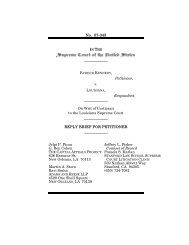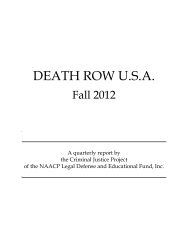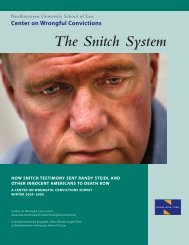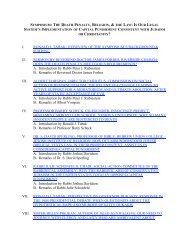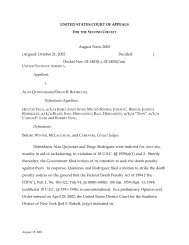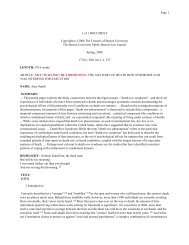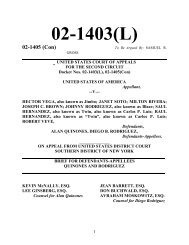Double Tragedies - Families for Human Rights
Double Tragedies - Families for Human Rights
Double Tragedies - Families for Human Rights
- No tags were found...
You also want an ePaper? Increase the reach of your titles
YUMPU automatically turns print PDFs into web optimized ePapers that Google loves.
exempting certain individuals with impaired mental capacityfrom the death penalty, but this legislative exemption hasbeen rarely applied. 4 Yet the Atkins v. Virginia and Roper v.Simmons rulings suggest a trend in this direction, and severalstates have begun to spearhead legislative and publiceducation campaigns in this area. The time has come <strong>for</strong> apublic debate on the question of exempting certain personswith severe mental illness from the death penalty.It is within this public debate that the voices representedat the San Antonio gathering become so important. Skepticsof the idea of exempting offenders with certain severe mentalillnesses from the death penalty might say that it is aninsult to victims’ families to claim that someone with mentalillness who commits a murder is less than fully culpable<strong>for</strong> that act and there<strong>for</strong>e should not face the death penalty.In terms of the traumatic impact on a victim’s family, murderscommitted by people with severe mental illness are noless devastating than any other murders. What messagedoes it send to victims’ families when such offenders are describedas less culpable <strong>for</strong> what they have done than are otherswho commit murder? Does this in any way deprivevictims’ families of an adequate societal acknowledgment ofwhat occurred? This question arises <strong>for</strong> victims’ families notonly in the context of the death penalty but also in the contextof a broader inquiry about what the appropriate responseshould be when an individual with severe mentalillness commits murder.Politically, supporting the death penalty <strong>for</strong> personswith severe mental illness, or at least opposing the idea ofexempting them from this penalty, would seem to be a provictimstance. Yet not all victims see it this way. <strong>Families</strong>of victims killed by persons suffering from severe mentalillness, who oppose the death penalty in these cases, have animportant statement to make on the issue. Their experienceand their reasons <strong>for</strong> opposing the death penalty should bepart of the public conversation.<strong>Families</strong> of victims killed by persons suffering from severemental illness who oppose the death penalty can helpshape societal response in ways that MVFHR and NAMIbelieve are of unique value. But in designing the joint projectthat came to be titled “Prevention, Not Execution,”MVFHR and NAMI also believed it essential to include anothergroup of stakeholders: the families of people withmental illness who have been executed. Questions about4Connecticut General Statutes § 53(a)-46(a) exempts a defendant from capitalprosecution if “his mental capacity was significantly impaired or his ability tocon<strong>for</strong>m his conduct to the requirements of law was significantly impaired butnot so impaired in either case as to constitute a defense to prosecution.”5Amnesty International’s 2006 report, “The Execution of Mentally Ill Offenders,”(see our List of Resources in Appendix C of this document) lists 100individuals with mental illness who have been executed in the United Statessince 1977. Amnesty writes, “This list represents about 10 per cent of thoseput to death in the country during this period, and is <strong>for</strong> illustrative purposesonly. It does not claim to be exhaustive – cases of others who have been executedhave also raised serious questions relating to their mental health.” Aswell, according to Mental Health America, an estimated 5-10% of inmates currentlyon death row in the United States have a serious mental illness. (SeeMental Health America’s “Position Statement 54: Death Penalty and Peoplewith Mental Illnesses.”)what might have been done to prevent the crime are theirquestions, too, made achingly specific by their (in manycases) years of frustrated attempts to get help <strong>for</strong> their illfamily member. These family members’ narratives of repeated,and thwarted, ef<strong>for</strong>ts to get treatment <strong>for</strong> their relativeswith mental illnesses infuse the “prevention, notexecution” phrase with an urgency grounded in direct experience.5In joining together to draw attention to the intersectionof mental illness, murder, and the death penalty, NAMI andMVFHR are highlighting a nexus of suffering between twogroups of families whose opposition to the death penalty isgrounded in personal tragedy. From the start, we have recognizeda risk inherent in framing a project in this way.Even with recent advances in both medical and public understandingof mental illness, those who live with these illnessesstill face enormous stigma. A risk inherent in aproject such as this one is that it will exacerbate the negativeportrayal of people with mental illness that many who livewith these illnesses and their advocates can quite rightlyclaim is already all too prevalent. The project is not arguingthat people with mental illnesses are inherently violent anddangerous. Indeed, we recognize that people with severemental illnesses are more often the victims than the perpetratorsof violence. 6We also recognize that the question of how to preventpeople with severe mental illness from committing violentcrimes is complicated tremendously by the very real need torespect the personal autonomy and civil liberties of such individuals.But in addition to a discussion of rights, this issuealso demands a discussion of obligations – specifically, a considerationof the obligations that a society has both towardits members who live with mental illness and toward the victimsof the crimes some have committed.The initial wariness felt by the families who came togetherin San Antonio was soon trans<strong>for</strong>med into a profound6The National Alliance on Mental Illness’s 2008 report on schizophrenia says,“The U.S. Surgeon General reported ten years ago that although some researchexists to support public concern, ‘the overall likelihood of violence is low’ andthe ‘overall contribution of mental disorders to the total level of violence in societyis exceptionally small.’ The ‘greatest risk’ is from persons dually diagnosedwith both a mental illness and a substance abuse disorder. There is alsoa ‘small elevation of risk’ <strong>for</strong> persons with severe disorders such as psychosis,‘especially if they are noncompliant with their medication.’Other studies support the U.S. Surgeon General’s basic assessment and theNational Institute of Mental Health (NIMH) has noted that substance abuse‘always increases violent behavior, regardless of the presence of schizophrenia.’Meanwhile, people with serious mental illnesses are as many as tentimes more likely to be victims of violence than the general public.” “Schizophrenia:Public Attitudes, Personal Needs; Views From People Living withSchizophrenia, Caregivers, and the General Public,”National Alliance on Mental Illness, June 2008.. See www.nami.org/schizophreniasurvey.For another useful summary, see “Increased Symptoms LeadMentally Disordered To Become Victims Of Violence” in Science Daily, April14, 2009, which opens by saying: “Contrary to common stereotypes, individualswith major mental disorders are more likely to become victims of violentcrimes when they are experiencing an increase in symptoms than theyare to commit crime, according to a new study by Brent Teasdale, an assistantprofessor of criminal justice at Georgia State University.” See also V.A.Hiday, M.S. Swartz, et al, “Criminal Victimization of Persons with SevereMental Illness,” Psychiatric Services 50: 62-68, January 1999.__ 2 __




